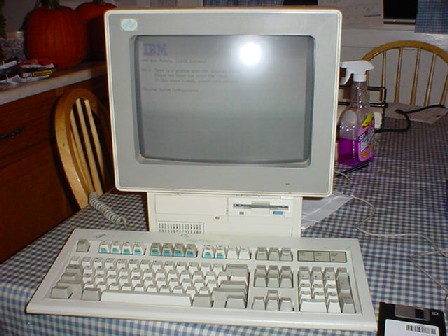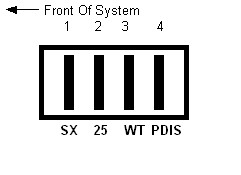EduQuest Model 55 (a REALLY turbocharged Model 25) 9615-001

Planar Outline
Option Cards
Flash BIOS Update
Picked this machine up from Twin City Computer Recycling (think that's the right business name) after winning it on eBay. A little muddy inside with corrosion on some planar stuff...tells me it sat out in the weather...but with IBM quality being what it is the machine works as though it were brand new.
Shown above in the picture is a keyboard with specially labeled function keys for some programs. Which ones, I don't know...but if anyone does there's an e-mail link on this page below that you can use...
Planar
You may notice that I don't have a whole lot of information on this system. IBM doesn't seem to have any info that I can find, and I've searched the web only to discover that I am one of the few people providing information on this system. If you have information on either the EduQuest 55 or any EduQuest, and it is preferably of a technical nature, please do send it to me for inclusion on this site. You will be given credit for your submissions.

Comments: Looks to me like this is a vastly revised planar as compared to the EduQuest 30 and 40 where lots of the design stayed the same with only minor changes. You really can't compare this planar to the 30 and 40 models.
Missing from this board are a lot of what I consider to have been "vestigial features" on the 30 and 40 such as the ever present but always empty "Mask ROM" socket.
Looking at U27 (LT1085 regulator commonly used for such things) and seeing no manual voltage switch I am inclined to believe that this board can automatically detect the voltage requirements of the CPU in use. There is a jumper not shown above that would let one select between 3.3 and 3.45 volts, but it is not populated (solder pads only) so that may be automatic as well.
Big Solder Pads are in an arrangement that looks like there may have been plans for a VL-bus version of this EduQuest.
Components:
Battery - CR2032
U8 - 512K Video RAM
U9 - 512K Video RAM - U8 and U9 total 1MB VRAM
U11 - VRAM Upgrade Socket
U12 - Intel Flash Chip (Flash BIOS update)
U13 - Marked as U13 ROM BIOS (could be used for bad flash recovery, this machine supports it)
U15 - Upgrade VRAM Socket
U16 - VLSI VL82C114
U17 - SMSC FDC37C65 (probably just a NEC 765 clone, so no 2.88 drives are supported)
U19 - Cirrus Logic 5434 Video
U23 - VLSI VL82C003
U26 - 80486/Pentium OverDrive Socket 3 (ZIF)
U27 - Linear Tech LT1085 Voltage Regulator
U38-53 Cache Sockets - U38 is probably the TAG RAM.
U54 - VL82C483
Jumpers/Connectors/Plugs:
SW1

Switches are "ON" when upwards
SX - Selects an i486SX or 'other' CPU
25 - Selects between 25 and 33MHz base clock speeds
WT - L1 Cache Operation Mode WT = Write-Thru or L1-WB = Level 1 Write Back
(write back improves performance drastically but may not be 100% compatible with certain processors and might increase the risk of data corruption on system failure)
PDIS - Your guess is as good as mine here...enables or disables parity---but for what?
JP1 - Power On Password Clear
JP2 - 1-2 (pin one is pads only) Boot Block Program, 2-3 Normal Operation (Models 30 and 40 have DOS in ROM, but there is no ROM DOS on the 55 so now I have no idea what this does...)
I'm not yet sure what the maximum amount of RAM this system can handle is. Wouldn't be suprised if it took 64MB. Appears to be standard non-parity stuff.
VRAM Sockets & Video Capabilities
Popped in two upgrade VRAMs into each socket and powered up. I was more than a little puzzled when the machine didn't report the new VRAM, but since they were rather crudely desoldered from another dead board, I figured maybe some pin straightening might be in order. That did the trick and got the system seeing all 2MB of installed VRAM.
Video is provided by a Cirrus 5434 accellerator. With 1MB VRAM you can run up to 256 colors in 1024x768. (Oddly enough 1MB is not enough VRAM for 800x600 at high color, only 256) With all 2MB installed, you can run at least high color in all supported modes (640x480 to 1024x768).
It appears that the video BIOS has been customized for the internal monitor, and all SVGA modes run at 72Hz scan rate. You can connect an external monitor, though what would change about the video chip's behavior I don't yet know. System setup has an option to disable the internal display if you're using modes it wouldn't support, so I will hook up a good multisync monitor and find out at some point.
Flash BIOS
Thanks to Tim O'Connor, who sent me a copy of an EduQuest 55 flash BIOS. I do not know if it is the last one released or not, but it took mine from revision 00G to revision 05G.
Download the self-extractor file here. This is the genuine and original IBM file.
Extraction may need to be done under pure DOS and not Windows NT, as when run on an NT system, no keyboard input to the program was possible.
NOTICE: Though most BIOS flash operations go as planned, errors are possible due to power failures, problems with the flash source and other little things that can go wrong. While I don't want to discourage you from applying this update if you need it, I don't advise applying it just because it is here and you can. Please make sure that your machine is in fact an EduQuest Model 55 and make the flash "undo diskette" prior to updating.
This update is provided on a "use at your own risk" basis. Neither Tim nor I are responsible for the results (good or bad) from updating your system's BIOS. If you mess it up, you are responsible for it.
This flash update supposedly fixes floppy drive read and write errors.
Go Back>